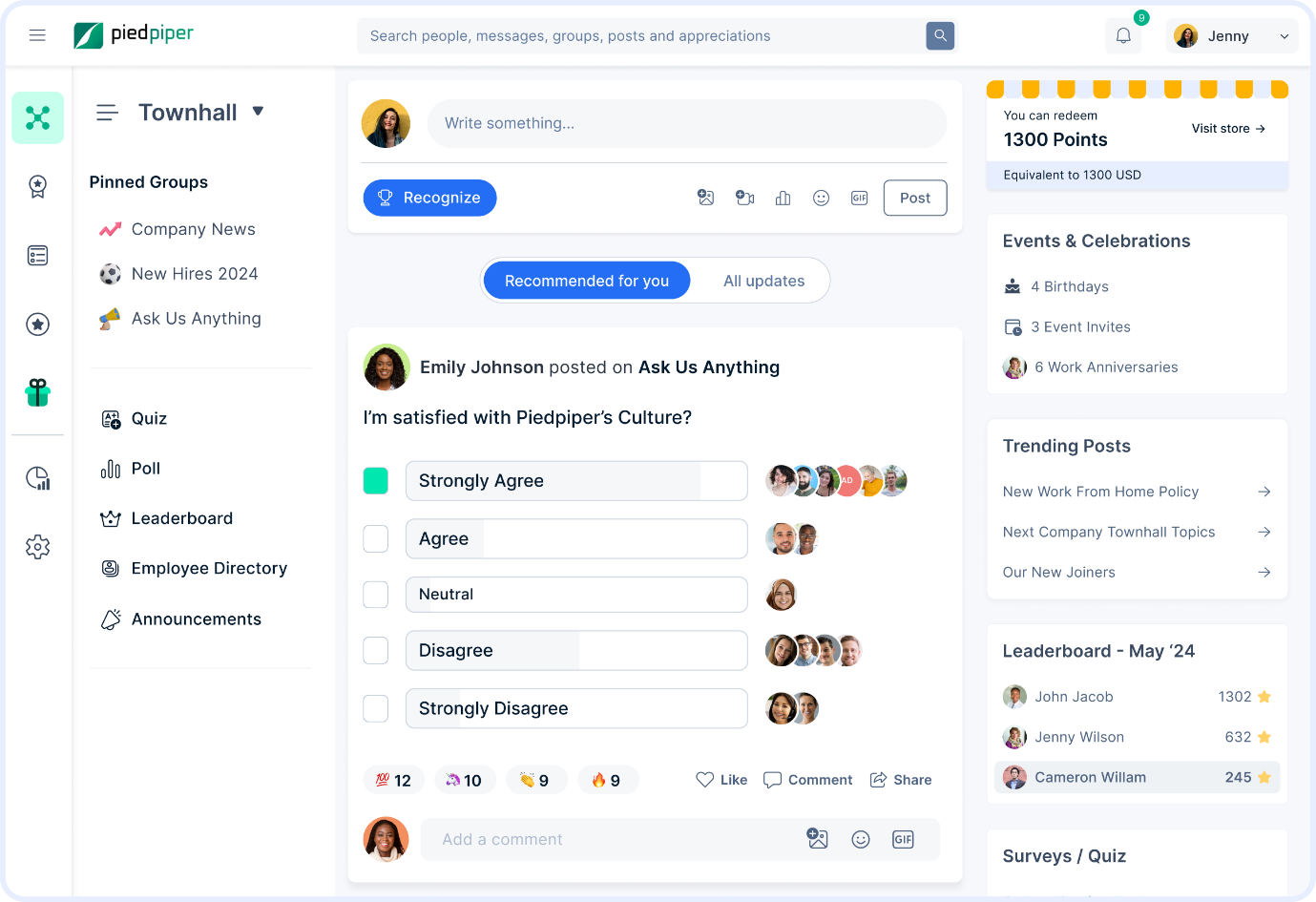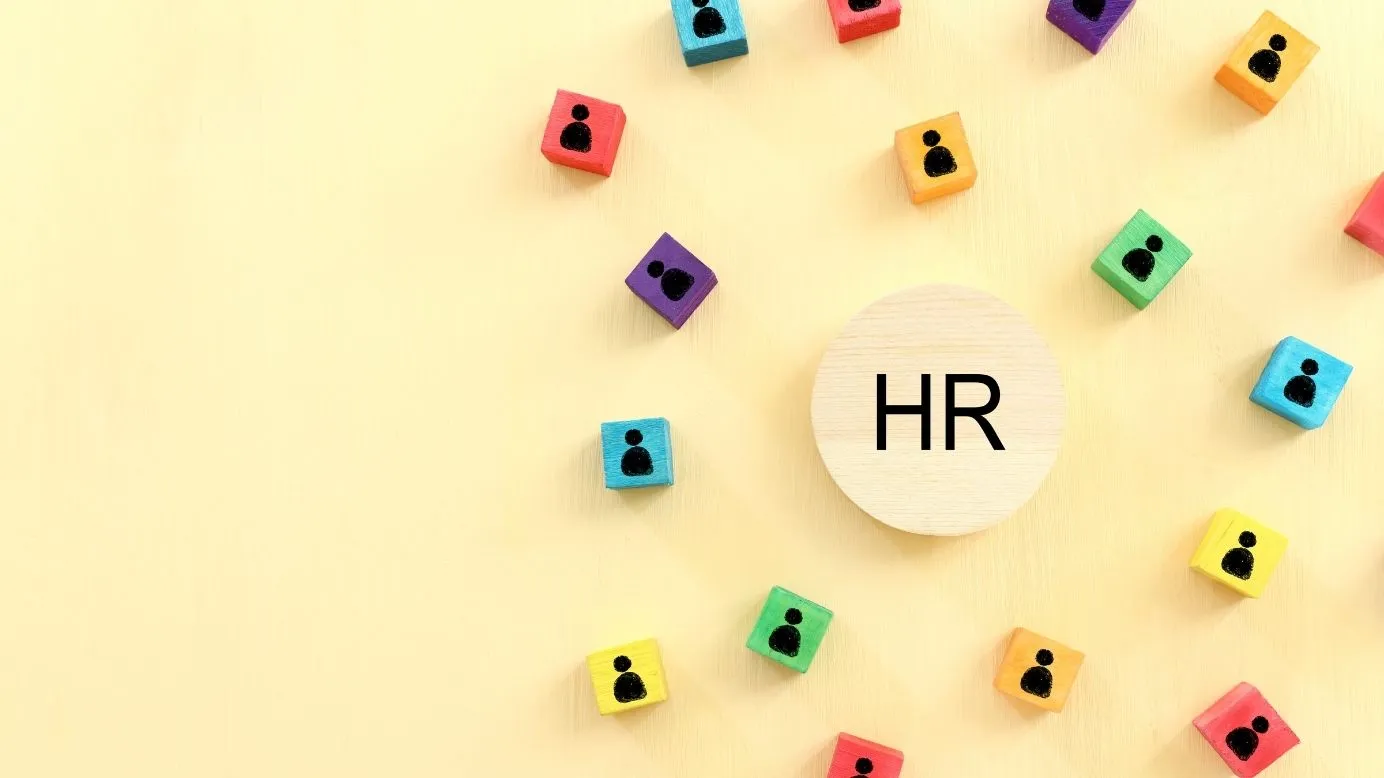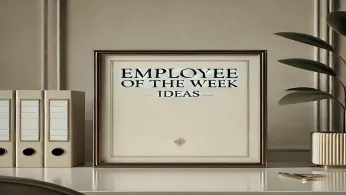The Evolving Role of HR in Engagement: Strategies for a Thriving Workforce
Explore the evolving role of HR in engagement. From hiring and onboarding to recognition and well-being, HR plays a key part in driving a motivated, loyal workforce.
Di halaman ini
Banyak organisasi di seluruh dunia harus beradaptasi dengan kondisi normal baru pada tahun lalu, dan hal ini tidak mudah bagi sebagian besar organisasi. Banyak orang kehilangan pekerjaan, dipaksa bekerja dalam kondisi yang tidak aman untuk mempertahankan atap di atas kepala mereka, dan harus tetap bekerja seperti bisnis seperti biasa sambil menghadapi kehilangan dan penderitaan yang tak terbayangkan.
HR berada di pucuk pimpinan dalam semua ini, mengemudikan kapal melewati perairan keruh ini. Kini, mereka menghadapi tantangan baru untuk membuat karyawan kembali bekerja di kantor. Sekali lagi, HR bertanggung jawab tidak hanya untuk memastikan bahwa tingkat produktivitas dipertahankan, namun juga untuk memastikan bahwa mereka terlibat dalam aktivitas organisasi.
They’re now also the ones who are responsible for hiring the manpower organizations lost in the past year and for streamlining the employee onboarding process and HR’s Role in it.
But before we delve deeper into HR’s Role in maintaining employee engagement and how it’s evolving, let’s talk about employee engagement in hr.
What is employee engagement in human resource management?
In the context of human resource management, employee engagement goes beyond job satisfaction or surface-level happiness. According to Forbes, it’s the emotional commitment an employee has toward their organization’s goals and values. This commitment drives motivation, discretionary effort, and loyalty—key drivers of productivity and retention.
Employee engagement in human resource management is now a strategic pillar that influences every stage of the employee lifecycle—from onboarding and learning to recognition and retention.
According to Forbes, employee engagement is the emotional commitment the employee has to the organization and its goals.
In the article by Kevin Kruse, the CEO of LEADx, employee engagement is not the same thing as employee satisfaction - or even employee happiness.
Apa Peran SDM dalam keterlibatan karyawan?
HR's Role is to ensure employee engagement throughout the times. Employee engagement itself is a relatively new phenomenon. Before the 1990s, HR was all about employee satisfaction and not much else, and no mind was given to whether the employee cared about their organization or not.
Fokus utama HR selalu mendapatkan hasil dari tenaga kerja, namun para ahli sekarang menganggap bahwa hal ini perlu diubah.
Dalam sebuah wawancara dengan Majalah Forbes, Lindsay Lagreid berbicara tentang perlunya SDM untuk mengambil pendekatan yang lebih berpusat pada karyawan di masa depan. Dia dan timnya di Limeade Institute memiliki penelitian yang cukup besar yang mendukung fakta bahwa perusahaan yang sukses adalah perusahaan yang peduli dengan karyawannya sebagai manusia. Menurut Lagreid sendiri, "HR adalah arsitek dari pengalaman karyawan dan perlu bertindak sebagai pendukung suara karyawan yang tak henti-hentinya kepada pimpinan."
Saat ini, semakin sulit bagi perusahaan untuk mempertahankan karyawan yang berbakat. Hal ini karena orang tidak lagi mencari pekerjaan yang stabil yang dapat mereka kerjakan seumur hidup.
Mereka mencari pertumbuhan, tantangan, karier yang bermanfaat, dan yang paling penting, mereka mencari kehidupan yang bahagia. Jika pekerjaan mereka menghalangi semua itu, mereka mungkin akan mempertimbangkan perubahan drastis dalam hidup mereka.
Let’s break down the core areas that define HR and employee engagement in today’s context:
1. Hiring with purpose and cultural alignment
Modern HR teams are no longer just filling open roles—they're curating experiences from day one. By hiring talent that aligns with the company’s purpose and values, HR lays the foundation for long-term engagement.
Recruiting isn't just about skills; it’s about identifying individuals who resonate with the organization's mission and are likely to thrive in its culture.
2. Designing meaningful onboarding experiences
Effective onboarding is one of the first opportunities HR has to engage employees. It's where employees learn not just what to do, but why their work matters.
Human resources professionals must ensure that onboarding is structured to communicate the organization’s vision, showcase leadership accessibility, and encourage early connection with peers—all of which contribute to engagement from the start.
3. Empowering managers to drive engagement
While HR designs the engagement strategy, it's often managers who implement it. That’s why human resources and employee engagement go hand in hand with leadership enablement.
HR needs to equip managers with data, tools, and training to recognize efforts, facilitate meaningful conversations, and foster team cohesion. When managers are supported, they become the frontline champions of engagement.
4. Creating opportunities for growth and purpose
One of the primary reasons employees disengage is a lack of growth. HR plays a vital role in building clear career paths, promoting internal mobility, and offering learning opportunities that align with both business goals and employee aspirations.
Moreover, by connecting day-to-day tasks with organizational impact, HR helps employees see purpose in their work—an essential component of engagement.
5. Measuring and acting on employee feedback
Data-driven HR functions rely on continuous listening. Tools like pulse surveys, engagement assessments, and eNPS scores are key to understanding how employees feel.
The HR role in employee engagement includes analyzing this feedback and driving actionable change. It's not enough to collect data—HR must act on it, close feedback loops, and communicate progress.
6. Recognizing and rewarding contributions
A well-structured recognition and rewards program can significantly boost morale. HR should create frameworks for peer-to-peer recognition, milestone celebrations, and values-based acknowledgments.
Recognition doesn't always have to be monetary. Personalized appreciation, public acknowledgment, and meaningful gestures can go a long way in building trust and boosting engagement.
7. Supporting well-being through holistic initiatives
The lines between work and life have blurred. As a result, human resources employee engagement strategies now include mental health resources, flexible benefits, and wellness programs.
When employees feel supported as individuals—not just workers—they are more likely to stay engaged and productive. HR plays a pivotal role in designing benefits that meet the diverse needs of a multigenerational workforce.
Evolusi peran SDM dalam keterlibatan karyawan
Seorang HR adalah fasilitator antara pekerja, manajer, dan pimpinan eksekutif. Jadi, tim HR memiliki peran penting dalam menjaga keterlibatan karyawan.
1. Manager's duty
Sesuatu seperti keterlibatan karyawan selalu ada di semua organisasi - hal ini terlihat dari cara banyak manajer menangani urusan sehari-hari di perusahaan dan di sekitar kantor, dalam cara mereka memastikan semua karyawan senang dan menumbuhkan tim yang erat yang saling mengandalkan satu sama lain untuk mewujudkan sesuatu.
This has always been the norm in great and successful companies. Still, now that it's been given a name and people realize how essential it is to success - especially post-lockdown when employee retention is harder than ever—HR has started to get involved.
Kini, HR bertugas memastikan bahwa para manajer diberdayakan untuk menumbuhkan kondisi yang diperlukan di sekitar tempat kerja untuk mendorong keterlibatan karyawan.
2. HR and how it evolves
Di tengah kondisi yang berubah ini, HR perlu mengubah strategi. Seperti yang telah kami sebutkan sebelumnya, sekarang perlu lebih fokus pada apa yang dibutuhkan karyawan untuk tetap terlibat dan bahagia dan mengadvokasi mereka dengan atasan daripada untuk atasan dan mendapatkan hasil yang mereka inginkan dari tenaga kerja perusahaan.
Untuk itu, mari kita bahas semua hal yang perlu diadaptasi oleh HR dan apa yang perlu dilakukan HR untuk memastikan kepuasan karyawan.
1. Perekrutan
Berikan lebih banyak fokus untuk merekrut karyawan yang tepat - karyawan yang menganggap pekerjaan ini menarik, atau yang masuk ke dalam bidang pekerjaan ini karena ingin melakukannya sebagai mata pencaharian. Atau, Anda bisa merekrut karyawan yang memiliki kesamaan dengan pesan organisasi Anda dan yang kehidupan pribadinya selaras dengan tujuan organisasi.
2. Job enrichment
Ambil langkah-langkah untuk membuat pekerjaan menjadi memuaskan dan bermakna. Hal ini mencakup membuat karyawan merasa memiliki tujuan dan kebutuhan, menyatakan kebutuhan mereka dengan jelas, dan membudayakan nilai-nilai yang adil di kantor. Karyawan harus mempercayai dan mengenali budaya kerja dan perannya.
3. Take regular surveys
You must run an employee engagement survey every year rather than employee satisfaction and rethink your strategies based on the results. Instead of focusing on what the employees need to do, what upper management wants them to do, HR should now focus on what employees need to be more engaged and what the company can do to facilitate these changes.
Keputusan investasi dan perubahan apa pun di tempat kerja harus dibuat berdasarkan hasil survei ini.
4. Training and onboarding new employees
Ketika karyawan baru mencapai tahap ini, HR perlu memberi tahu mereka bagaimana mereka cocok dengan perusahaan dan bagaimana kontribusi mereka penting dan membuat peran mereka terlihat berarti bagi karyawan. Tekankan bagaimana mereka adalah bagian penting dalam memajukan misi organisasi dan mengambil langkah untuk menindaklanjuti janji dan klaim ini.
Strategies for the HR to evolve in the modern landscape
Strategic Role of HR in Modern Workplaces
HR is no longer just about policies, payroll, and compliance. It’s about engineering employee experience, advocating for people, and enabling business growth. Post-pandemic, as the workforce seeks flexibility, purpose, and well-being, HR must take a people-first approach. Here's how:
1. Hire with purpose & cultural fit
Strategy: Move beyond CVs and skills—hire for mission alignment and cultural fit. Look for candidates who resonate with the organization's purpose.
Facilitates cultural onboarding with town halls, vision-sharing posts, and an AI assistant ("Em") to guide new hires, making them feel aligned from Day 1
2. Create a human-centric onboarding experience
Strategy: Replace transactional onboarding with meaningful, connection-focused onboarding. Introduce them to your values, team culture, and leadership early.
Offers a social intranet, rich media onboarding, and community groups to foster belonging from the start.
3. Foster a culture of continuous listening
Strategy: Use regular eNPS, pulse, and lifecycle surveys to understand evolving employee sentiment. Act on feedback visibly to build trust.
Supports all types of engagement surveys, including onboarding, exit, and 360° feedback. AI-powered insights help HR and managers take immediate, data-backed actions.
4. Empower and equip managers
Strategy: Enable managers to be the frontline ambassadors of engagement. Equip them with tools to recognize, coach, and connect with their teams.
Provides managers with AI nudges, recognition insights, and team engagement data to act in real-time and bridge recognition gaps.
5. Build recognition into daily workflow
Strategy: Recognition should be frequent, timely, and meaningful—peer-to-peer and top-down. Link it to core values and key milestones.
Offers structured R&R programs, 15+ award types (peer, spot, milestone), and automations to ensure no moment goes unnoticed. Personal Recognition Assistant nudges teams to acknowledge efforts weekly.
6. Offer purpose-driven growth & learning
Strategy: Provide internal mobility, learning budgets, and mentorship programs. Align employee aspirations with business goals.
Gamifies learning, offers learning rewards, and ties recognitions to KPIs or development goals.
7. Enable flexible and equitable rewards
Strategy: Recognize diverse needs with a flexible, global rewards ecosystem. Incorporate experiences, perks, charity, and lifestyle benefits.
Global rewards catalog (1M+ choices), fringe benefits (LSA), early wage access, and tax-saving benefits—all available in multiple currencies and languages
8. Promote well-being & financial wellness
Strategy: Support the whole human: mental health, family needs, financial stability. Make well-being integral, not optional.
Offers salary advance, discounts across 6000+ brands, fitness, travel, remote work allowances, and a complete lifestyle benefits platform.
9. Build belonging through communication
Strategy: Create a transparent, respectful workplace culture with open dialogue. Celebrate milestones, wins, life events.
Empuls’ social intranet and community groups encourage peer bonding, open conversations, and real-time feedback loops.
How Empuls supports HR in driving engagement
Following is Empuls can drive change for your organization.

1. Hiring, onboarding & alignment: Empuls supports cultural onboarding through social intranet, town halls, org charts, and AI assistant “Em” to guide new joiners. Share vision-aligned content and create engaging onboarding experiences.
2. Surveys & feedback: eNPS, pulse & lifecycle surveys to listen across the employee journey. AI-driven insights help HR and managers act on real-time feedback.
3. Empowering managers: Managers receive nudges and insights to recognize team members, close recognition gaps, and drive inclusive engagement.
4. Growth & motivation: Set up structured reward cycles, gamify experiences, and link recognitions to core values, KPIs, and milestones. Drive performance through learning incentives, peer-to-peer recognition, and service awards.
5. Recognition & rewards: Supports 15+ award types, including spot, jury-based, milestone, team and peer awards. Offers a global rewards catalog: 1M+ choices from gift cards, experiences, charity, merch, and more.
6. Perks & well-being: Empuls helps stretch paychecks via:
- Salary advance & early wage access
- Exclusive perks & discounts (6,000+ brands)
- Tax-saving & fringe benefits through Lifestyle Spending Accounts.
7. Communication & belonging: Empuls’ social intranet fosters transparent communication, community groups, polls, celebration boards, and feedback loops.
+67% eNPS improvement
+90% feel more valued & recognized
+1.5x growth in company revenue
+87% less likely to leave the company
Empuls is purpose-built to help HR evolve from a compliance-focused function to a strategic engagement partner—empowering them to design employee experiences that drive loyalty, performance, and well-being. Schedule a call now!
Kesimpulan
Departemen SDM di perusahaan-perusahaan di seluruh dunia kini berurusan dengan tenaga kerja yang memiliki pendekatan yang sangat berbeda terhadap pekerjaan dan karier mereka dibandingkan dengan tenaga kerja dua dekade lalu.
Keterlibatan karyawan menjadi lebih relevan saat ini dibandingkan sebelumnya, dengan meningkatnya persaingan dan tekanan pada organisasi untuk menjadi lebih baik, dan betapa pentingnya keterlibatan karyawan dalam perjuangan ini.
Gone are the days when the end goal of HR was to ensure mere employee satisfaction, and new HR approaches and policies need to reflect this. Still, with the help of some retraining and an adaptive attitude that focuses more on employee wellbeing, this won't be too hard to achieve!
Pertanyaan Umum
What does HR do for employee engagement?
HR designs programs, activities, and policies that promote a positive work culture, recognition, career development, communication, and employee well-being to boost engagement.
How can HR measure employee engagement?
HR uses tools like employee surveys, feedback forms, one-on-one meetings, exit interviews, and metrics such as retention rates, absenteeism, and productivity levels.
What are the 4 types of employee engagement?
The four types of employee engagement are:
- Highly Engaged: Motivated and committed to the organization.
- Moderately Engaged: Generally satisfied but not emotionally invested.
- Disengaged: Unmotivated and indifferent toward work.
- Actively Disengaged: Unhappy and possibly spreading negativity.
What is the HR objective of employee engagement?
To foster a motivated, productive, and committed workforce that contributes positively to organizational goals and reduces turnover.













